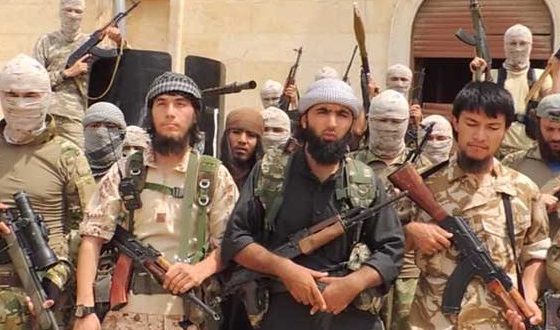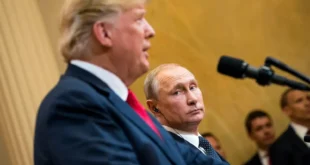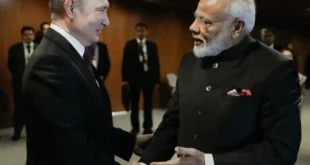leonid Gusev
Central Asian countries experience diverse intersecting influences: they feel changes in the situation in the Caucasus, in the Xinjiang autonomous territory of China, in Afghanistan and the Middle East. Militants from various terrorist groups in the region cooperate, many of them fighting in Syria and Iraq. But the biggest threat to Central Asia’s security is the situation in Afghanistan, where the Taliban provide organisational and logistics support to the Islamic Movement of Uzbekistan (IMU). Despite sustaining a significant blow, with its main groups squeezed out of the region, it still maintains a presence in the form of underground groups that could become active at any time, joining forces with the radical Tajik opposition and Uyghur separatists. Cells of the Islamic State (ISIS) (a terrorist organisation banned in Russia) also operate in the region.
Kazakhstan: Effective Peacekeeping Measures
The main conduits of terrorist ideology in Kazakhstan are Islamist movements and organisations. In order to minimise their effect on people’s minds, the Kazakhstan government has undertaken a number of measures to improve religious education and ensure society’s spiritual development.
A special body, the Agency for Religious Affairs, was established for this purpose in 2011. Another step was the screening of over 9,000 web portals, which led to 51 foreign sites being banned in Kazakhstan for promoting extremism and terrorism.
Terrorist activity in Kazakhstan has an important international political dimension. Members of Uyghur extremist organisations are active in the country. Some experts note the possibility of a merger between Kazakh underground forces and Uyghur separatists. Uyghur terrorist organisations are quite powerful. There is also the risk that terrorist groups established in oil-rich areas of the Caspian and northeastern Kazakhstan and the spread of jihadist ideology there could jeopardise China’s future interests in the region.
A new trend is for radical Islamists to engage increasingly in crime while ordinary criminals are themselves turning to radical Islamism, particularly in western Kazakhstan. Prisons have become breeding grounds for Islamic extremism (as in Kyrgyzstan and some Russian regions). All prisons in Kazakhstan have turned “green,” which is the term for institutions informally controlled by Islamists (as opposed to “black” prisons, which are controlled by traditional criminals, and “red” ones, where the prison administration is in full control).
The authorities are stepping up their fight against terrorism. In 2016–2017, many extremists in the country were arrested, including those with connections to criminal circles and illegal schemes (such as oil theft in western Kazakhstan).
In 2018, the National Security Committee of Kazakhstan developed a state programme for countering religious extremism and terrorism in Kazakhstan for 2018–2022. It will be funded out of the national and local budgets, as well as other funds not prohibited per Kazakhstan law. Budgetary spending on the programme will total almost 287 bn tenges (USD 747 bn).
The programme calls for border control, identification and blocking of channels used by religious extremists and terrorists for entering the Republic of Kazakhstan and importing prohibited materials into the country, including involving illegal immigration and counterfeit documents. It also provides for training law-enforcement officers and improving the facilities and infrastructure for local police inspectors.
The measures taken by Kazakhstan to counter terrorism, as well as the government’s policy of tolerance towards all religions and nationalities, is generally helping to maintain security in the country.
Tajikistan: Situation Under Control So Far
In recent years, the Tajik government has stepped up its efforts to counter extremist groups.
As in the other countries of the region, the main recruiting platform used by ISIS (a terrorist organisation banned in Russia) in Tajikistan is the Internet. There are some 3 million Internet users in Tajikistan, 80 per cent of them accessing extremist content through social media either deliberately or accidentally.
During their meeting in May 2018, President of Tajikistan Emomali Rahmon and President of Belarus Alexander Lukashenko expressed their commitment to strengthening cooperation in the fight against terrorism, extremism, drug trafficking and the illegal arms trade. In October 2019, Tajikistan hosted a joint military exercise of the Collective Security Treaty Organisation (CSTO) member states, “Indestructible Brotherhood 2019.” One of the components of that exercise, according to Commander of the Central Military District of the Russian Federation, Colonel-General Alexander Lapin, consisted of antiterrorist operations.
Tajikistan is a tension hotspot in Central Asia in terms of religious extremism and terrorism. A particular source of danger is neighbouring Afghanistan, where about 60 per cent of the lands along the frontier are engulfed in clashes between government forces and the Taliban and other radical Islamist groups.
At the same time, there is almost no security along the Afghan-Tajik border, including the issue of drug trafficking. The local Tajik forces supporting border guards are scant, especially since the Kulob Regiment was relocated from the 201st Russian military base to Dushanbe. Yet the government has so far managed to control the situation.
Uzbekistan: Iron-Fisted Control
The Uzbek government traditionally pursues a rigorous policy in countering religious extremism and terrorism. At the same time, extremist entities in Uzbekistan (especially the Islamic Movement of Uzbekistan [IMU]) are the strongest and most aggressive in the region. The IMU has proven to be a long-term threat and is currently cooperating with Al Qaeda and the Pakistani terrorist group Lashkar-e-Taiba. In the late 1990s, the IMU consisted of several hundred Uzbek and Tajik militants. In contrast, today it includeshundreds of thousands of militants from all the Central Asian countries, as well as China, Turkey, Azerbaijan and Chechnya.
The ultimate reasons for the rise in extremism in Uzbekistan lie in its political, socioeconomic and inter-ethnic problems, which are especially typical of the most populated areas of the Fergana Valley. The Fergana and Karategin valleys are still convenient platforms for covert terrorist activity.
One landmark event was the signing of a joint comprehensive action plan for 2018–2019 to counter the online activities of extremist and terrorist groups (code name Clean Net) between Uzbekistan and Tajikistan.
Uzbek authorities and security forces have the situation in the country under control.
Kyrgyzstan: Bad Influence from Neighbours
Extremist groups traditionally threaten the southern part of Kyrgyzstan from neighbouring Tajikistan and Uzbekistan. One reason is the country’s weak law enforcement. The extremists are mostly members of the Uzbek diaspora, while ethnic Kyrgyz are less involved, primarily owing to a low level of Islamisation.
Yet the Kyrgyz have begun to fall under the influence of pseudo-educational groups like Hizb ut-Tahrir (which does not formally pursue military action but is included in the lists of terrorist organisations maintained by the security services of key global states).
A new trend has emerged in recent years with Jihadist groups forced out from Kyrgyzstan starting to exert an influence on Salafi jamaats in the country. Once in prison, members of these organisations are sometimes reported to convert their cellmates into loyal supporters in a short time.
The latest terrorist operation was the suicide bombing attack near the Chinese embassy building in Bishkek.
Since then, however, the Kyrgyz authorities have stepped up their fight against religious extremism and the influence of various Salafi movements, which is a somewhat positive trend.
According to the United Nations, the number of people convicted of terrorism and religious extremism in Kyrgyzstan has increased 5.3-fold, from 79 in 2010 to 422 in 2017. One in five of these is a woman.
The Ministry of the Interior of Kyrgyzstan reports that 4,470 people, including 865 women, were convicted of extremist crimes from January to April 2018 alone.
Turkmenistan
In early October 2018, a Financial Monitoring Service was set up under the Ministry of Finance and Economics to fulfil tasks envisaged by the Law of the Republic of Kazakhstan “On Countering Money Laundering and Financing of Terrorism.”
Earlier, during a visit by the President of Russia to Turkmenistan in 2017, the two countries agreed to continue exerting joint efforts in fighting terrorism and the illicit drug trade.
In mid-November 2019, consultations were held in Ashgabat on cooperation between CIS countries in countering terrorism. Representatives of Russia, Kazakhstan, Belarus, Kyrgyzstan, Tajikistan, Turkmenistan, Uzbekistan and Armenia discussed possible ways of expanding joint antiterrorist activities within the framework of international organisations.
The participants also exchanged views on preventive measures against extremism, radicalisation of the population and financing of terrorism, noting the importance of engaging civil society and the media to increase the impact.
Specialised training was also considered, including on the use of modern technologies to mount a timely response against potential threats.
All this shows that Turkmenistan is adopting a more aggressive antiterrorist policy.
Forecast
Central Asian countries have recently stepped up the fight against terrorism and extremism, as can be seen from the lack of overt terrorist activities in the last three years. This means they need to pursue closer cooperation with one another and with Russia, as well as with the OSCE and the Shanghai Cooperation Organisation (SCO) to continue the fight against extremism.
OSCE forces can already be used to resolve issues caused by the increase in terrorist activity on the periphery of Afghanistan. A Working Group on Afghanistan has been set up for this purpose under the Council of Foreign Ministers of the CSTO. It analyses the situation and elaborates proposals for promoting the post-conflict restoration of Afghanistan, including by countering the drug trafficking and terrorist threats emanating from the country.
A Coordination Council of the Heads of Competent Authorities for Countering Illicit Drug Trafficking has been established under the OSCE, with a specific mandate to eliminate drugs based on Afghan opiates. Joint work is underway to create and strengthen anti-drug and financial “security belts” around Afghanistan and to augment mechanisms for putting a stop to drug trafficking as part of operation Kanal (Channel).
Even so, the OSCE forces need to be strengthened, and a better legal framework is required for their use. The main forces available to the OSCE in the Afghan direction are the Collective Rapid Deployment Forces (CRDF) and the Collective Rapid Response Forces (CRRF). Exercises carried out by the CRDF and CRRF focus on reflecting potential invasion by the Taliban and by Taliban-supported extremist and terrorist groups from the south. Escalation of the situation around Afghanistan may require the OSCE’s military tools to be strengthened (greater numbers, more equipment, more frequent joint exercises).
A crucial decision could be to turn the OSCE into a focal point for international efforts for resolving problems related to Afghanistan. This might require creating regional coalitions between the OSCE and other international entities, both post-Soviet (SCO) and Euro-Atlantic (the EU and NATO), to counter the terrorist threat in Central Asia.
As regards cooperation with Euro-Atlantic actors, this should be based on the “selective partnership” principle, i.e., it should not compromise Russia’s interests in other areas where it has disagreements with the West. It would be reasonable to establish coalitions not between individual states but between regional organisations, using a network model (i.e., with cooperation primarily along the lines of individual programmes), which could provide for more flexible threat responses.
As for the SCO, it would make sense to strengthen its Regional Anti-Terrorist Structure (RATS) based in Tashkent. Another step to consider might consist of dedicating standing units under the SCO to counter drug trafficking and extremism. Also worth researching is the feasibility of a joint police force and its potential organisational structure.
Antiterrorist efforts should address the financing of terrorism in particular. Terrorists trade drugs to get their hands on considerable funds so the “anti-drug belt” around Afghanistan (the leading global source of opiates) must be strengthened.
Other financing channels used by terrorists and extremists must also be blocked. For example, a recent trend is the financing of terrorist organisations through ordinary shops selling groceries and household goods and passing on the profits to terrorists. It is often quite challenging to track the use of a shop’s profits.
To summarise, the scenario unfolding in Central Asia is not a critical one, the governments of the region are in control of the situation, and the region will remain stable in the coming years.
 Geostrategic Media Political Commentary, Analysis, Security, Defense
Geostrategic Media Political Commentary, Analysis, Security, Defense





